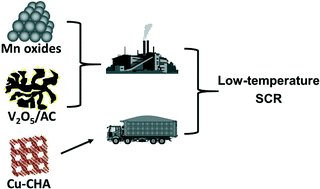Catalysts for the selective catalytic reduction of NOx with NH3 at low temperature
Abstract
Selective catalytic reduction of NOx with NH3 (NH3-SCR) at low temperature is a major challenge in environmental catalysis. In recent years, great efforts have been devoted to the development of low-temperature SCR catalysts for both stationary sources and diesel engines. Mn-based catalysts have attracted great attention due to their excellent low-temperature activity. However, vulnerability to SO2 and H2O poisoning and preference for N2O formation make these catalysts still far away from industrial application. V2O5 loaded on carbon materials has shown both high SCR activity and SO2 tolerance at low-temperature. This type of catalyst is very promising for applications in low-temperature SCR for stationary sources. Recently, Cu-containing small pore zeolites, such as Cu-SSZ-13 and Cu-SAPO-34 with a CHA structure and Cu-SSZ-39 and Cu-SAPO-18 with an AEI structure, were shown to have very high activity at low temperature and excellent hydrothermal stability at high temperature and thus received much attention for applications on diesel vehicles. In this review, we will focus on the recent studies on low-temperature NH3-SCR catalysts. In addition, the future directions of low-temperature SCR development will also be discussed.


 Please wait while we load your content...
Please wait while we load your content...